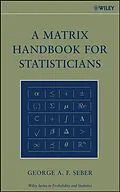A comprehensive, must-have handbook of matrix methods with a unique
emphasis on statistical applications
This timely book, A Matrix Handbook for Statisticians, provides
a comprehensive, encyclopedic treatment of matrices as they relate
to both statistical concepts and methodologies. Written by an
experienced authority on matrices and statistical theory, this
handbook is organized by topic rather than mathematical
developments and includes numerous references to both the theory
behind the methods and the applications of the methods. A uniform
approach is applied to each chapter, which contains four parts: a
definition followed by a list of results; a short list of
references to related topics in the book; one or more references to
proofs; and references to applications. The use of extensive
cross-referencing to topics within the book and external
referencing to proofs allows for definitions to be located easily
as well as interrelationships among subject areas to be
recognized.
A Matrix Handbook for Statisticians addresses the need for
matrix theory topics to be presented together in one book and
features a collection of topics not found elsewhere under one
cover. These topics include:
* Complex matrices
* A wide range of special matrices and their properties
* Special products and operators, such as the Kronecker
product
* Partitioned and patterned matrices
* Matrix analysis and approximation
* Matrix optimization
* Majorization
* Random vectors and matrices
* Inequalities, such as probabilistic inequalities
Additional topics, such as rank, eigenvalues, determinants,
norms, generalized inverses, linear and quadratic equations,
differentiation, and Jacobians, are also included. The book assumes
a fundamental knowledge of vectors and matrices, maintains a
reasonable level of abstraction when appropriate, and provides a
comprehensive compendium of linear algebra results with use or
potential use in statistics. A Matrix Handbook for Statisticians is
an essential, one-of-a-kind book for graduate-level courses in
advanced statistical studies including linear and nonlinear models,
multivariate analysis, and statistical computing. It also serves as
an excellent self-study guide for statistical researchers.
Autorentext
George A. F. Seber, PhD, is Emeritus Professor in the Department of Statistics at The University of Auckland in New Zealand. A Fellow of the New Zealand Royal Society, he is the author or coauthor of several books, including Nonlinear Regression, Multivariate Observations, Adaptive Sampling, Chance Encounters, and Linear Regression Analysis, Second Edition, all published by Wiley. Dr. Seber's research interests have included statistical ecology, genetics, epidemiology, and adaptive sampling.
Klappentext
A comprehensive, must-have handbook of matrix methods with a unique emphasis on statistical applications
This timely book, A Matrix Handbook for Statisticians, provides a comprehensive, encyclopedic treatment of matrices as they relate to both statistical concepts and methodologies. Written by an experienced authority on matrices and statistical theory, this handbook is organized by topic rather than mathematical developments and includes numerous references to both the theory behind the methods and the applications of the methods. A uniform approach is applied to each chapter, which contains four parts: a definition followed by a list of results; a short list of references to related topics in the book; one or more references to proofs; and references to applications. The use of extensive cross-referencing to topics within the book and external referencing to proofs allows for definitions to be located easily as well as interrelationships among subject areas to be recognized.
A Matrix Handbook for Statisticians addresses the need for matrix theory topics to be presented together in one book and features a collection of topics not found elsewhere under one cover. These topics include:
-
Complex matrices
-
A wide range of special matrices and their properties
-
Special products and operators, such as the Kronecker product
-
Partitioned and patterned matrices
-
Matrix analysis and approximation
-
Matrix optimization
-
Majorization
-
Random vectors and matrices
-
Inequalities, such as probabilistic inequalities
Additional topics, such as rank, eigenvalues, determinants, norms, generalized inverses, linear and quadratic equations, differentiation, and Jacobians, are also included. The book assumes a fundamental knowledge of vectors and matrices, maintains a reasonable level of abstraction when appropriate, and provides a comprehensive compendium of linear algebra results with use or potential use in statistics. A Matrix Handbook for Statisticians is an essential, one-of-a-kind book for graduate-level courses in advanced statistical studies including linear and nonlinear models, multivariate analysis, and statistical computing. It also serves as an excellent self-study guide for statistical researchers.
Inhalt
Preface. 1. Notation. 1.1 General Definitions. 1.2 Some Continuous Univariate Distributions. 1.3 Glossary of Notation. 2. Vectors, Vector Spaces, and Convexity. 2.1 Vector Spaces. 2.1.1 Definitions. 2.1.2 Quadratic Subspaces. 2.1.3 Sums and Intersections of Subspaces. 2.1.4 Span and Basis. 2.1.5 Isomorphism. 2.2 Inner Products. 2.2.1 Definition and Properties. 2.2.2 Functionals. 2.2.3 Orthogonality. 2.2.4 Column and Null Spaces. 2.3 Projections. 2.3.1 General Projections. 2.3.2 Orthogonal Projections. 2.4 Metric Spaces. 2.5 Convex Sets and Functions. 2.6 Coordinate Geometry. 2.6.1 Hyperplanes and Lines. 2.6.2 Quadratics. 2.6.3 Miscellaneous Results. 3. Rank. 3.1 Some General Properties. 3.2 Matrix Products. 3.3 Matrix Cancellation Rules. 3.4 Matrix Sums. 3.5 Matrix Differences. 3.6 Partitioned Matrices. 3.7 Maximal and Minimal Ranks. 3.8 Matrix Index. 4. Matrix Functions: Inverse, Transpose, Trace, Determinant, and Norm. 4.1 Inverse. 4.2 Transpose. 4.3 Trace. 4.4 Determinants. 4.4.1 Introduction. 4.4.2 Adjoint Matrix. 4.4.3 Compound Matrix. 4.4.4 Expansion of a Determinant. 4.5 Permanents. 4.6 Norms. 4.6.1 Vector Norms. 4.6.2 Matrix Norms. 4.6.3 Unitarily Invariant Norms. 4.6.4 M,N-Invariant Norms. 4.6.5 Computational Accuracy. 5. Complex, Hermitian, and Related Matrices. 5.1 Complex Matrices. 5.1.1 Some General Results. 5.1.2 Determinants. 5.2 Hermitian Matrices. 5.3 Skew-Hermitian Matrices. 5.4 Complex Symmetric Matrices. 5.5 Real Skew-Symmetric Matrices. 5.6 Normal Matrices. 5.7 Quaternions. 6. Eigenvalues, Eigenvectors, and Singular Values. 6.1 Introduction and Definitions. 6.1.1 Characteristic Polynomial. 6.1.2 Eigenvalues. 6.1.3 Singular Values. 6.1.4 Functions of a Matrix. 6.1.5 Eigenvectors. 6.1.6 Hermitian Matrices. 6.1.7 Computational Methods. 6.1.8 Generalized Eigenvalues. 6.1.9 Matrix Products 103. 6.2 Variational Characteristics for Hermitian Matrices. 6.3 Separation Theorems. 6.4 Inequalities for Matrix Sums. 6.5 Inequalities for Matrix Differences. 6.6 Inequalities for Matrix Products. 6.7 Antieigenvalues and Antieigenvectors. 7. Generalized Inverses. 7.1 Definitio…
